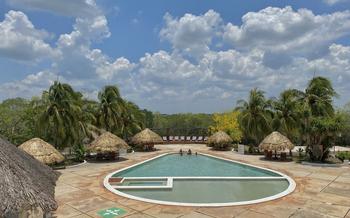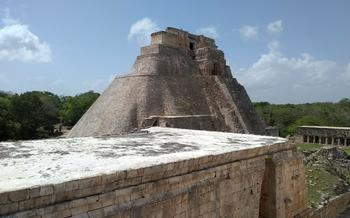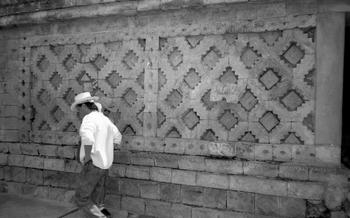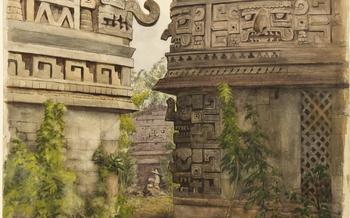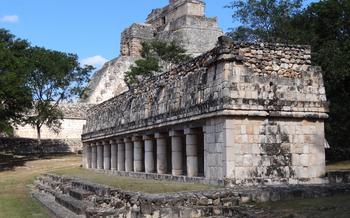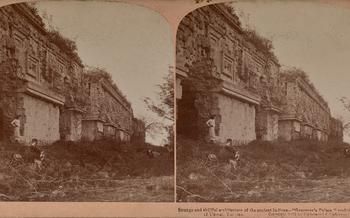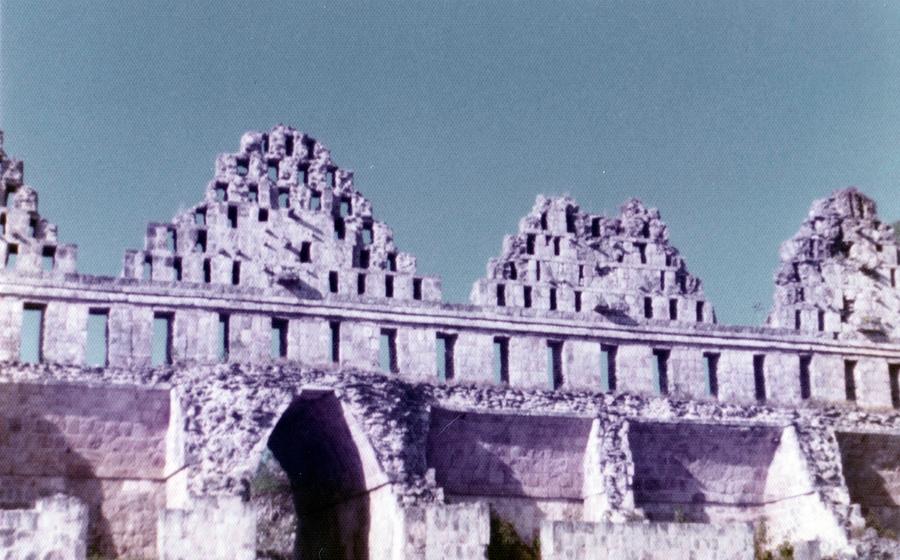
Palomar Quadrangle
- The Palomar Quadrangle: A Complex of Ancient Structures
- The Pyramid of the Magician: A Towering Wonder
- The Governor's Palace: A Place of Power and Administration
- The Great Pyramid: A Symbol of Astronomical Knowledge
- The Nunnery Quadrangle: A Complex of Residential Structures
- The Ball Court: A Place for Ritual Games
- The House of the Turtles: A Unique Architectural Gem
- The Quadrangle of the Birds: A Place of Natural Beauty
- The Temple of the Old Woman: A Place of Mystery and Intrigue
- The Cenote X'Cacay: A Sacred Water Source
- The Uxmal Light and Sound Show: A Multisensory Experience
- Exploring the Region: Nearby Attractions
- Insider Tip: Unveiling the Secrets of Uxmal
The Palomar Quadrangle: A Complex of Ancient Structures
Located at the heart of Uxmal, the Palomar Quadrangle is a remarkable complex of ancient structures that showcases the architectural prowess and cultural significance of the Maya civilization. This quadrangle, also known as the Central Plaza, forms the core of the ancient city and is surrounded by some of the most iconic buildings of Uxmal.
The quadrangle is characterized by its symmetrical layout and impressive architectural features. The buildings that enclose the space are constructed using the Puuc architectural style, which is unique to the northern Yucatán Peninsula. This style is characterized by the use of intricate stone carvings, corbelled arches, and elaborate friezes.
The Palomar Quadrangle holds great historical and cultural significance. It was once the center of political and religious power in Uxmal, and it served as a gathering place for the Maya people. The quadrangle was also used for important ceremonies and rituals, and it was a place where the Maya rulers would receive visitors and conduct business.
Notable structures within the quadrangle include the Pyramid of the Magician, the Governor's Palace, and the Great Pyramid. These buildings are all architectural masterpieces and offer a glimpse into the advanced civilization that once thrived in Uxmal.
The Pyramid of the Magician: A Towering Wonder
Standing tall amidst the ancient ruins of Uxmal, the Pyramid of the Magician, also known as the Great Pyramid, is an architectural marvel that commands attention and awe. With a height of approximately 35 meters, it is the tallest structure in the city, rising majestically above the surrounding buildings. The pyramid's imposing presence is a testament to the advanced engineering skills and architectural prowess of the ancient Maya civilization.
Constructed using the corbelled arch technique, the pyramid features five distinct levels, each showcasing intricate stonework and decorative elements. The facade of the pyramid is adorned with elaborate sculptures depicting Chac, the Mayan rain god, as well as other mythological figures. These intricate carvings provide valuable insights into the religious beliefs and artistic traditions of the Maya people.
The construction of the Pyramid of the Magician is shrouded in mystery and legend. One popular myth tells the tale of a magician who used his supernatural powers to build the pyramid in a single night. Another legend suggests that the pyramid was built by a giant who carried stones from distant lands using a magical sash.
For those willing to make the climb, the pyramid's summit offers breathtaking panoramic views of the surrounding jungle and the ancient city of Uxmal. The ascent requires caution and sturdy footwear due to the steep and narrow steps, but the reward is an unforgettable vista that will leave you spellbound.
The Governor's Palace: A Place of Power and Administration
The Governor's Palace, also known as the Palace of the Governors, stands as a testament to the grandeur and power of the ancient Maya rulers. Its imposing façade, adorned with intricate carvings and sculptures, reflects the architectural mastery of this ancient civilization.
With dimensions of approximately 100 feet in length and 50 feet in width, the palace boasts a series of interconnected rooms and chambers, each serving a specific purpose in the governance and administration of the city. The palace's central courtyard, surrounded by colonnades and decorated with elaborate stucco friezes, was likely used for public gatherings and ceremonies.
Inside the palace, visitors can marvel at the intricate carvings and sculptures that adorn the walls and doorways. These bas-reliefs depict scenes from Mayan mythology, historical events, and the daily lives of the ruling elite. Particularly noteworthy is the "Throne of the Governor," a massive stone seat carved with the figure of a jaguar, a symbol of power and authority among the Maya.
The Governor's Palace is not merely a showcase of artistic prowess; it also offers a glimpse into the political and administrative structure of ancient Uxmal. It served as the seat of power for the city's rulers, who oversaw the city's affairs, managed trade and agriculture, and maintained diplomatic relations with neighboring city-states.
This magnificent edifice stands as a testament to the organizational skills and engineering prowess of the ancient Maya. Its well-preserved state allows visitors to step back in time and imagine the bustling activity that once filled its halls, as rulers, priests, and scribes carried out the tasks of governing this ancient metropolis.
The Great Pyramid: A Symbol of Astronomical Knowledge
The Great Pyramid, also known as the Pyramid of the Magician, stands as a testament to the Mayans' advanced knowledge of astronomy. Its architectural design and alignment are meticulously crafted to coincide with celestial events, particularly the summer solstice. During this time, the setting sun casts a shadow on the pyramid's northwest corner, creating the illusion of a serpent descending the steps. This phenomenon, known as the "solstice serpent," is a captivating sight that draws visitors from around the world.
Rising to a height of over 30 meters, the Great Pyramid's imposing presence reflects the Mayans' mastery of construction techniques. Its steep sides and rounded corners give it a distinctive profile, while its interior chambers and passageways remain shrouded in mystery. The pyramid's alignment with astronomical events suggests that it served as an observatory, allowing Mayan priests to track the movements of the sun, moon, and stars, and to predict celestial events with remarkable accuracy.
The Great Pyramid was a focal point for religious ceremonies and rituals, with its elevated position symbolizing a connection between the earthly and spiritual realms. It is believed that the pyramid's alignment with the summer solstice was a significant event in the Mayan calendar, marking the beginning of a new agricultural cycle and a time of renewal. The pyramid's grandeur and astronomical significance made it a sacred site for the Mayans, a place where they could connect with the divine and seek guidance from the cosmos.
The Nunnery Quadrangle: A Complex of Residential Structures
Located to the west of the Great Pyramid, the Nunnery Quadrangle is a complex of residential structures that once housed Mayan priests and royalty. This quadrangle is notable for its unique architectural features, including long, narrow rooms arranged around a central courtyard. The rooms feature thick walls, vaulted ceilings, and small windows, providing a cool and shaded living space.
The Nunnery Quadrangle is believed to have been used for both residential and ceremonial purposes. It is adorned with various decorative elements, including intricate carvings, sculptures, and friezes depicting scenes from Mayan mythology and daily life. Among the notable structures within the complex are the House of the Pigeons, named for the dove-like birds depicted on its facade, and the Temple of the Masks, featuring a row of grotesque masks representing the Mayan death god.
The Nunnery Quadrangle offers a glimpse into the daily life and rituals of the Mayan elite. It is a testament to the advanced architectural skills of the Mayans and their ability to create functional and aesthetically pleasing living spaces.
The Ball Court: A Place for Ritual Games
Located on the eastern side of the Palomar Quadrangle, the ball court is a testament to the Mayans' passion for their national sport. Measuring 150 feet long and 30 feet wide, with walls that rise to a height of 20 feet, this impressive structure served as a stage for the ritualistic ball game that held deep cultural and religious significance.
The rules of the game, known as Pok-ta-Pok, were complex and varied, but the objective was generally to propel a solid rubber ball through a stone hoop attached to the wall. This required skill, strength, and agility, as players could only use their hips, elbows, and knees to strike the ball.
Beyond its sporting aspect, the Mayan ball game was steeped in symbolism and mythology. The hoop represented the portal to the underworld, and the ball itself was considered a sacred object associated with the sun and fertility. The outcome of the game was believed to have implications for agricultural yields and the well-being of the community.
Today, visitors can witness a reenactment of the Mayan ball game at Uxmal, performed by skilled players wearing traditional Mayan attire. This thrilling spectacle brings to life the ancient traditions and rituals that once took place within these walls, offering a glimpse into the rich sporting heritage of the Mayans.
The House of the Turtles: A Unique Architectural Gem
Amidst the grandeur of Uxmal's ancient structures, the House of the Turtles stands out as a unique architectural gem. Located on the east side of the Great Pyramid, this building showcases the intricate artistry and symbolism of the Maya civilization.
The House of the Turtles derives its name from the numerous turtle sculptures that adorn its facade. These turtles, considered sacred animals by the Maya, represent fertility, creation, and the connection between the earth and the underworld. The turtles are depicted in various poses, some crawling, some swimming, and others emerging from their shells, symbolizing the cycle of life and rebirth.
The building itself is a testament to Mayan craftsmanship. Constructed from finely cut limestone blocks, the House of the Turtles features a corbelled arch, a technique used by the Maya to create vaulted ceilings without the use of true arches. The interior of the building is adorned with elaborate stucco friezes and paintings, depicting scenes from Mayan mythology and daily life.
The significance of the turtles in Mayan culture extended beyond their symbolic meaning. Turtles were also a source of food and were often depicted in Mayan art and iconography. The presence of turtle sculptures on the House of the Turtles suggests that the building may have been used for ceremonies or rituals related to fertility and agriculture.
Today, the House of the Turtles stands as a reminder of the rich cultural and artistic heritage of the Maya. Its intricate carvings and sculptures offer a glimpse into the beliefs and practices of this ancient civilization, making it a must-visit attraction for anyone exploring the wonders of Uxmal.
The Quadrangle of the Birds: A Place of Natural Beauty
Nestled amidst the ancient ruins of Uxmal, the Quadrangle of the Birds stands as a testament to the Mayans' deep connection to nature. This quadrangle derives its name from the intricate carvings of birds that adorn its walls, symbolizing the sacredness of wildlife in Mayan culture.
The quadrangle comprises a series of low, rectangular structures arranged around a central courtyard. While the exact purpose of these structures remains a mystery, it is believed that they were used for ceremonies and rituals related to the natural world. The courtyard itself is a haven of tranquillity, with lush vegetation and the gentle sounds of birdsong creating a serene ambiance.
Visitors to the Quadrangle of the Birds can take a moment to appreciate the beauty of the surrounding nature. The quadrangle is home to a variety of birds, including parrots, toucans, and hummingbirds, which flit through the trees and fill the air with their melodious calls. The presence of these birds adds a touch of magic to the ancient ruins, creating a sense of harmony between the natural world and the human-made structures.
Whether you are a nature enthusiast, a birdwatcher, or simply someone who appreciates the beauty of the natural world, the Quadrangle of the Birds is a must-visit destination within the ancient city of Uxmal. Take a moment to sit in the courtyard, listen to the songs of the birds, and let the tranquility of this sacred space wash over you.
The Temple of the Old Woman: A Place of Mystery and Intrigue
Tucked away in a secluded corner of Uxmal, the Temple of the Old Woman stands as an enigmatic and captivating structure. Legend has it that this temple was once the home to an elderly Mayan woman who possessed magical powers and the ability to communicate with the gods. Locals whispered tales of her wisdom and her ability to heal the sick and injured, making the temple a place of pilgrimage and reverence.
The temple's architectural features are unique and intriguing, showcasing intricate carvings and sculptures that depict various deities and mythical creatures. Its interior chambers are adorned with colorful murals and bas-reliefs, providing glimpses into the rich mythology and religious beliefs of the ancient Mayans.
While the exact purpose of the temple remains shrouded in mystery, it is believed to have been a sacred place where priests and shamans performed religious ceremonies and rituals. The temple's design and symbolism suggest that it was dedicated to the worship of a powerful female deity, possibly associated with fertility, healing, and the underworld.
Exploring the Temple of the Old Woman is a journey into the realm of Mayan spirituality and folklore. Visitors can immerse themselves in the temple's mystical atmosphere, marvel at its intricate artwork, and let their imaginations wander as they uncover the secrets of this enigmatic and captivating place.
The Cenote X'Cacay: A Sacred Water Source
In the heart of Uxmal, a sacred water source known as the Cenote X'Cacay lies concealed within a natural limestone sinkhole. This cenote, with its crystal-clear waters and otherworldly atmosphere, holds a deep cultural and religious significance for the ancient Mayans.
The Mayans believed that cenotes were portals to the underworld, serving as gateways to communicate with the gods and ancestors. The Cenote X'Cacay was particularly revered, as it was thought to be a place where the rain god Chaac descended to earth.
In addition to its spiritual importance, the Cenote X'Cacay served as a vital water source for the inhabitants of Uxmal. During the dry season, when water was scarce, the Mayans relied on the cenote for their daily needs, using it for bathing, drinking, and irrigation.
Today, visitors to Uxmal can descend into the Cenote X'Cacay through a series of stone steps, immersing themselves in its refreshing waters and marveling at the stalactites and stalagmites that adorn its walls. The cenote provides a unique opportunity to connect with the ancient Mayan culture and experience the sacredness of this natural wonder.
The Uxmal Light and Sound Show: A Multisensory Experience
As the sun sets over the ancient city of Uxmal, a magical transformation takes place. The ruins come alive with vibrant colors, enchanting projections, and stirring music, immersing visitors in the rich history and culture of the Mayans. The Uxmal Light and Sound Show is a must-see experience that brings the storied past of this ancient city to life.
The show unfolds over approximately 45 minutes, painting a vivid tapestry of Uxmal's grandeur and significance. Through a captivating blend of lights, projections, and music, the show narrates the city's rise and fall, its architectural marvels, and the lives of its inhabitants. The ruins themselves become a canvas upon which the story of Uxmal is projected, creating a breathtaking spectacle that leaves visitors in awe.
To fully appreciate the show, it's recommended to arrive at the site around 30 minutes before the scheduled start time to secure a good viewing spot. The show is presented in Spanish, but English headsets are available for rent at the entrance for a minimal fee.
Whether you're a history buff, a culture enthusiast, or simply seeking a unique and awe-inspiring experience, the Uxmal Light and Sound Show is an unforgettable journey into the heart of the ancient Maya civilization. Let the magic of light, sound, and storytelling transport you to a time when Uxmal stood as a testament to the ingenuity and artistry of the Maya people.
Exploring the Region: Nearby Attractions
Beyond the wonders of Uxmal, the region boasts a wealth of other captivating attractions that are well worth exploring. The nearby city of Merida, the capital of Yucatan, is a vibrant cultural hub with a rich colonial heritage. Its colorful streets, charming plazas, and impressive architecture offer a glimpse into Mexico's past. Take a leisurely stroll through the city center, visit the magnificent Merida Cathedral, and admire the stunning murals that adorn the Palacio de Gobierno.
For those seeking a deeper immersion into the ancient Maya world, the Ruta Puuc, a circuit of Maya cities located south of Merida, is a must-visit. This route includes several well-preserved sites, such as Kabah, Sayil, and Labna, each with its unique architectural features and historical significance. Explore the impressive pyramids, intricate carvings, and beautifully restored temples that dot this region.
The haciendas of Yucatan offer a glimpse into the region's fascinating history and agricultural heritage. These former agricultural estates, many of which have been converted into luxury hotels, provide a unique blend of history, culture, and natural beauty. Spend a day exploring the lush grounds, admiring the colonial architecture, and learning about the region's traditional farming practices.
To make the most of your time, consider planning day trips or guided tours to these nearby attractions. Many tour operators in Uxmal offer organized excursions that provide transportation, expert commentary, and hassle-free itineraries. Whether you choose to explore independently or with a guided group, the surrounding region offers a wealth of experiences that will enrich your understanding of Mexico's rich cultural heritage.
Insider Tip: Unveiling the Secrets of Uxmal
Unlock the full potential of your Uxmal experience with these insider tips. Capture stunning photographs by arriving early to avoid harsh midday lighting and using a tripod to steady your shots. To escape the crowds, plan your visit during the weekdays or shoulder seasons (May-June and September-October). Enhance your understanding by engaging with local guides who can share captivating stories and insights about Uxmal's history and culture. Don't miss the opportunity to savor local delicacies at nearby restaurants, such as traditional Mayan dishes and refreshing beverages. Embark on a culinary adventure and discover the flavors that complement the rich history of Uxmal. Embrace the opportunity to create lasting memories and immerse yourself in the captivating world of this ancient Mayan city.


